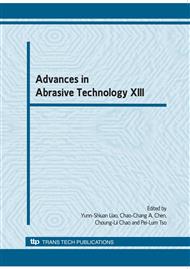p.773
p.779
p.785
p.791
p.796
p.802
p.808
p.817
p.823
The Kinematical Performance Analysis of a Kind of Parallel Turning-Grinding Machine
Abstract:
This paper presents a new type of two 2-DOF Parallel 2PRR institution, with the unique advantages such as simple motion modeling and easy calculation of the positive and negative solution, operating a large space, simple structure and easy to control, etc. This parallel mechanism can not only be used for the development of glass cutting, grinding materials, milling, processing equipment, spare parts and other planes, but also can be used as a multi-DOF hybrid machine tool flat actuator parallel mechanism which can give full play the advantages of strong reconfiguration, with the main different combinations of auxiliary bodies and set up to meet the individual needs of the user reconfigurable manufacturing cell to be more complex parts processing and high-speed machining.
Info:
Periodical:
Pages:
796-801
Citation:
Online since:
August 2010
Authors:
Keywords:
Price:
Сopyright:
© 2010 Trans Tech Publications Ltd. All Rights Reserved
Share:
Citation:


